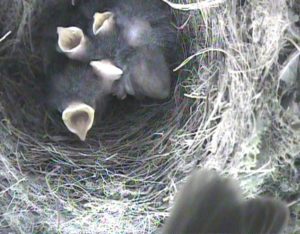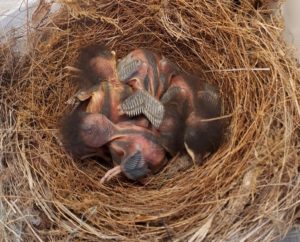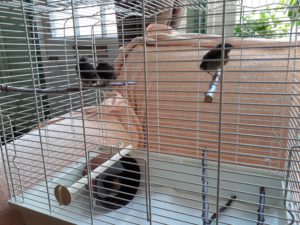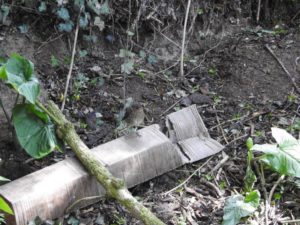
How one DToL scientist raised four robin chicks
As part of the team that manages deliveries of organism samples to the Wellcome Sanger Institute, Radka Platte knows a thing or two about facing multiple demands all at once. But none of it compared to the moment she and her husband suddenly found themselves the adoptive parents of four baby robins — the genome for which we recently published here.
Inspired by SpringWatch, for the past eight years Radka has had a nest box in her garden rigged up to a camera. It’s never guaranteed that the local resident robin (whom Radka has named “Bob”) and his mate will nest in the camera nest box. But spring 2021 began very promisingly.

They watched as the nest was built, as Bob fed the female (always “Mrs. Bob”, despite being a different female most years). And then a “small miracle” happened, Radka explains.
“All five of the eggs hatched into chicks. Into these beautiful little dinosaurs — naked, blind, pink, but amazing. Very, very healthy looking, very alive.”

The robins became international stars. Radka shared their videos with friends and family, including many in the Czech Republic. “I suddenly had a big audience for this exciting story in the pandemic which was cheering everybody up.”

Then, 5 days after the robins hatched, disaster struck. “On Good Friday morning, we woke up to a very fuzzy picture on the screen coming from the nest cam. And so I went to check it out and saw that the nest was turned on its side, and the chicks were alive inside.”
Radka suspects a predator, possibly one of the neighbourhood cats. In a previous year, one cat had systematically picked off an entire brood of robins as they fledged, emerging one by one from the nest.
Radka and her husband didn’t know what to do. The parents had survived the attack but weren’t helping the chicks, who were getting steadily colder. One chick died that morning. Radka took the remaining four inside, warmed them up and fed them some mealworms, then placed them back in the nest.

But the mother wasn’t brooding them. The nest was disturbed and the parents instinctively abandoned it. The mother even started attacking her chicks. At this point, with a frosty night due, Radka took the chicks inside permanently.
“We thought what on earth are we going to do? Is it even right? But we just thought, let’s see what happens overnight. And they were all well and alive in the morning.”

Radka was particularly concerned about potentially breaking the law, and sought advice from several sources. It is illegal to disturb a wild bird’s nest, carrying a fine of up to £5,000 or six months jail time. However, there are exceptions if you want to care for sick, injured or orphaned birds with the sole purpose of tending them and releasing them back into the wild.
No local animal rescue organisations could take the robins. Many were at capacity or disrupted by the pandemic. There was also an outbreak of avian flu which prevented many organisations taking in birds at the time.
However, several animal rescue experts were happy to advise over the phone. Various people had different ideas, and much of the process involved educated guesses and doing what felt right.

“We learned from one another,” says Radka. “I learned what to do with the chicks, what to feed them, how to look after them. They were learning how to be robins — and we all survived the experience!”
As they grew, the robins graduated from a pudding bowl, to a bigger pudding bowl, to just the base of a cage, to the entire cage, and finally a three-person mosquito-netted tent. Radka’s husband rigged up apple twigs and bamboo sticks to teach them to perch, hop and then eventually fly.

They avoided petting the chicks, and even recorded the sound of a wild robin (sadly not Bob himself) to play them from a smartphone. “I’ve got to show them who they are,” Radka explained. “Classic FM is all very well, but they’re not going to relate to that in the wild.”

The care regime was intense. Although the birds slept soundly through the night, once awake they were incredibly demanding. They needed feeding on the hour. Radka recalls tiptoeing around in the morning so as not to wake them, and how going on a Zoom call would set them off chirping for attention.
Eventually, after three weeks of caring for the robins, a space opened up at a local wildlife rescue centre. After another week in their own outdoor aviary, the fledglings were ready to strike out on their own.

Everyone on the Darwin Tree of Life project loves nature, but few have as close a bond to a particular species as Radka does to robins.
As part of the Tree of Life Sample Management Team at the Wellcome Sanger Institute, Radka’s job is critical in making sure the organism samples collected in the field are all correct and accounted for before they begin genome sequencing.
That includes helping teams in the field submit samples to Sanger by guiding them through the process — this has to be done by the book, and Radka works closely with the legal and research governance teams to ensure this. The team organises shipments, receiving and safely storing samples in the freezers, and also making sure all the details of each sample are recorded correctly.

“I feel privileged to be part of this crazy, ambitious, amazing project. And to be working with so many brilliant, clever, very nice people. I hope to stay here for a good long while,” she says.
But as high as the stakes get on the project — and there are some costly consequences to checking in the wrong organism samples or mixing up the paperwork — it will never match the experience of raising her robins.
“It was stressful and amazing at the same time. I had this enormous responsibility for four lives.”
